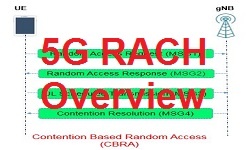5G NR Bandwidth Part (BWP)
A Bandwidth Part (BWP) is a contiguous set of physical resource blocks (PRBs) on a given carrier. These RBs are selected from a contiguous subset of the common resource blocks for a given numerology (u). It is denoted by BWP. Each BWP defined for a numerology can have following three different parameters.
- Subcarrier spacing
- Symbol duration
- Cyclic prefix (CP) length

BWP Configuration Properties
- UE can be configured with maximum 4 BWP for Downlink and Uplink but at a given point of time only one BWP is active for downlink and one for uplink.
- BWP concept enable UEs to operate in narrow bandwidth and when user demands more data (bursty traffic) it can inform gNB to enable wider bandwidth.
- When gNB configures a BWP , it includes parameters: BWP Numerology (u) BWP bandwidth size Frequency location (NR-ARFCN), CORESET (Control Resource Set)
- With respect to Downlink ,UE is not expected to receive PDSCH, PDCCH, CSI-RS, or TRS outside an active bandwidth part
- Each DL BWP include at least one CORESET with UE Specific Search Space (USS) while Primary carrier at least one of the configured DL BWPs includes one CORESET with common search space (CSS)
- With respect to uplink, UE shall not transmit PUSCH or PUCCH outside an active bandwidth part
- UEs are expected to receive and transmit only within the frequency range configured for the active BWPs with the associated numerologies. However, there are exceptions; a UE may perform Radio Resource Management (RRM) measurement or transmit sounding reference signal (SRS) outside of its active BWP via measurement gap
BWP Activation/Deactivation and Switching
According to 38.321-5.15 Bandwidth Part (BWP) operation, BWP selection (or BWP switching) can be done by several different ways as listed below.
- Dedicated RRC Signaling
- Over PDCCH channel Downlink control information (DCI)- DCI 0_1 (UL Grant) and DCI 1_0 (DL Scheduling)
- By bwp-inactivityTimer – ServingCellConfig.bwp-InactivityTimer
- By MAC CE (Control Element)
DCI based mechanism, although more prompt than the one based on MAC CE, requires additional consideration for error case handling, i.e. the case when a UE fails to decode the DCI containing the BWP activation/deactivation command. To help to recover from such a DCI lost scanarios, the activation/deactivation of DL BWP (or DL/UL BWP pair for the case of unpaired spectrum) by means of timer (bwp-inactivityTimer) is also introduced. With this mechanism, if a UE is not scheduled for a certain amount of time, i.e. expiration of timer, the UE switches its active DL BWP (or DL/UL BWP pair) to the default one.
There is an initial active BWP for a UE during the initial access until the UE is explicitly configured with BWPs during or after RRC connection establishment. The initial active BWP is the default BWP, unless configured otherwise.
As per 3GPP Release 15, for a UE, there is at most one active DL BWP and at most one active UL BWP. The HARQ retransmission across different BWPs is supported when a UE’s active BWP is switched.
Why BWP is Required?
A wider Bandwidth has direct impact on the peak and user experienced data rates, however users are not always demanding high data rate. The use of wide BW may imply higher idling power consumption both from RF and baseband signal processing perspectives. In regards to this , new concept of BWP has been introduced for 5G-NR provides a means of operating UEs with smaller BW than the configured CBW, which makes NR an energy efficient solution despite the support of wideband operation.
Alternatively, one may consider to schedule a UE such that it only transmits or receives within a certain frequency range. Compared to this approach, the difference with BWP is that the UE is not required to transmit or receive outside of the configured frequency range of the active BWP, which attributes power saving from the following aspects:
- BWP concept reduce bandwidth processing requirement to transmit or receive narrow bandwidth
- BWP enable RF-Baseband interface operation with a lower sampling rates
- UE RF bandwidth adaptation can provide UE power saving at least if carrier bandwidth before adaptation is large.
Related Post
- Hybrid Core Network – 4G Core to 5 G Core Interconnection
- Deployments Scenarios for 5G-NR
- 5G Key Performance Indicator Definitions Template by 3GPP
- 5G End to End KPI – Accessibility, Integrity and Utilization
- 5G NR gNB Logical Architecture and Its Functional Splits
- 5G NR gNB High Layer Split



